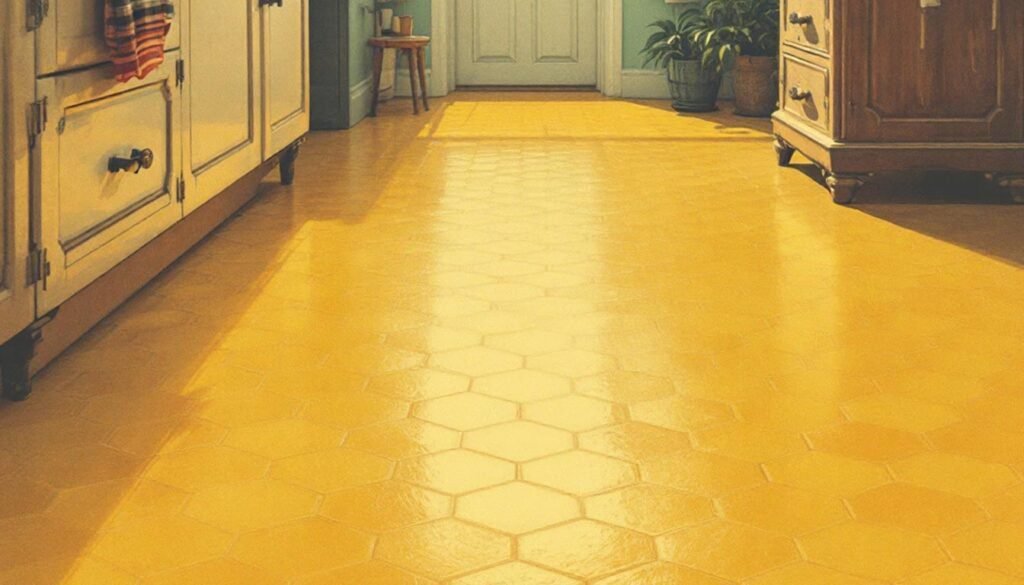Introduction to Linoleum Flooring
Linoleum flooring is a resilient and eco-friendly flooring option that has captured the interest of homeowners and commercial property managers alike. Its historical significance dates back to the mid-19th century when it was first introduced as a durable and versatile material for various applications. Made primarily from natural ingredients such as linseed oil, pine resin, cork dust, and jute fabric, linoleum flooring stands out as a sustainable choice that exemplifies both functionality and environmental responsibility.

One of the key aspects of linoleum flooring is its composition. Unlike synthetic alternatives, linoleum is crafted from renewable resources, making it biodegradable and a much greener choice for those seeking sustainable materials. The manufacturing process of linoleum involves a series of steps that blend these natural ingredients, resulting in a product that is not only aesthetically pleasing but also long-lasting and easy to maintain. This commitment to natural materials contributes to its appeal, especially for eco-conscious consumers.
Over the years, linoleum has seen a resurgence in popularity as modern design trends embrace its unique textures and patterns. Available in an assortment of colors, styles, and finishes, linoleum flooring can complement a wide range of interior design themes—from traditional to contemporary spaces. Its reputation for durability is another significant factor; linoleum can withstand heavy foot traffic, making it an ideal flooring option for both residential and commercial environments.
In conclusion, as the demand for sustainable and attractive flooring options continues to grow, linoleum flooring emerges as a compelling choice. Its combination of eco-friendliness, durability, and design versatility positions it as a favorable alternative to more common flooring materials, thus encouraging individuals and businesses to consider it for their next renovation or construction project.
The Eco-Friendly Benefits of Linoleum Flooring
Linoleum flooring stands out in the realm of sustainable materials due to its composition and production process. Primarily made from natural, renewable resources such as linseed oil, cork dust, and wood flour, linoleum is not only durable but also an eco-conscious choice for any environment. The use of these materials ensures that the flooring is free from toxic substances, setting it apart from many synthetic alternatives that can pose risks to both health and the environment.
Also Read Trending Post
- 20 High Protein Meal Prep Ideas for Weight Loss, Muscle Gain & Busy Lifestyles (2025 Guide)
- Healthy and Sustainable Rooftop Gardening Guide for Beginners: Simple and Effective Methods
- Eco-Friendly Meal Prep Ideas: 10 Essential Tips for Healthy and Sustainable Eating
- Microplastics: Invisible Danger in Our Food, Water, and Environment
- Top 25 Plant-Based Protein Sources Chart: Your Ultimate Visual Guide for a Healthier Diet!
One of the major advantages of linoleum flooring is its biodegradability. Unlike plastic-based options, linoleum breaks down naturally, thus reducing the burden on landfills. When a linoleum floor reaches the end of its life cycle, it can decompose in a way that is safe for the environment, leaving a minimal ecological footprint. This characteristic is increasingly essential as society moves towards more sustainable building practices and materials. By investing in linoleum flooring, consumers contribute to a circular economy, promoting a life cycle that prioritizes environmental health.
Furthermore, linoleum flooring has low volatile organic compound (VOC) emissions, which means it contributes to better indoor air quality. This is particularly relevant in a time when many people are becoming more conscious of the air they breathe inside their homes and workplaces. Lower VOC emissions are crucial for reducing health risks and creating healthier living spaces, aligning with the sustainable ethos many consumers are adopting.
In addition, choosing linoleum flooring can also help individuals and businesses lessen their carbon footprints. The production process of linoleum requires significantly less energy compared to traditional flooring options, leading to lower overall emissions of greenhouse gases. Therefore, by opting for linoleum, one supports a product that not only serves aesthetic and functional purposes but also champions the cause of environmental stewardship.
Durability and Longevity of Linoleum
Linoleum flooring is widely recognized for its impressive durability, making it a preferred choice among homeowners and commercial property owners alike. This material is made from natural ingredients, such as linseed oil, cork dust, wood flour, and natural pigments, which contribute to its robust characteristics. When properly installed and maintained, linoleum can easily withstand the daily rigors of high-traffic areas while maintaining its aesthetic appeal over time.
One of the significant advantages of linoleum flooring is its resistance to scratches and dents. Unlike many synthetic flooring options, linoleum has a tough surface that offers a high degree of protection against day-to-day wear and tear. This inherent toughness not only helps in maintaining the floor’s appearance but also ensures that the material remains functional for years. Additionally, linoleum is also resistant to stains, making it a practical choice for kitchens and dining areas where spills are frequent. Its easy-to-clean surface allows homeowners to maintain hygiene without excessive effort.
Another factor contributing to the longevity of linoleum flooring is its ability to withstand moisture. While it is essential to avoid soaking the surface, linoleum can resist minor water exposure, preventing damage that occurs in other flooring types, such as hardwood or laminate. This moisture resistance, combined with proper care, enhances the lifespan of linoleum floors significantly. Simple maintenance steps, such as regularly sweeping, mopping with mild detergents, and promptly addressing spills, can greatly extend the overall durability of the flooring system.

In summary, linoleum flooring offers a resilient solution that provides both style and functionality. Thanks to its natural composition and resistance to common household challenges, linoleum remains a viable option for those seeking long-lasting flooring solutions.
Stylish Aesthetics: Design Options with Linoleum
Linoleum flooring has gained popularity not only for its eco-friendly attributes and durability but also for its stunning aesthetic appeal. The design options available with linoleum are vast, making it a versatile choice for various interior styles. Homeowners and designers appreciate the broad spectrum of colors, patterns, and finishes that linoleum can offer, allowing it to blend seamlessly into diverse environments.
One of the most attractive features of linoleum flooring is its extensive color palette. From rich, earthy tones to vibrant, bold shades, there is a color to suit every taste and preference. These colors can enhance the ambiance of a space, whether one seeks a warm, inviting feel in a living room or a fresh, energetic vibe in an office setting. Moreover, the ability to choose contrasting hues opens up opportunities for creative designs, enabling the creation of unique looks that stand out.
Patterns also play a significant role in the allure of linoleum flooring. Modern linoleum options come in various designs, including geometric shapes, natural motifs, and classic textures, which can mimic the appearance of wood or stone. These patterns can add depth and interest to a room, serving as a captivating focal point or background. Linoleum’s versatility allows it to adapt to any style preference, from contemporary aesthetics to rustic charm.
Additionally, finishes such as matte or gloss can further refine the look of linoleum flooring, allowing for additional customization. This aspect makes linoleum an excellent choice for both residential and commercial spaces, where aesthetics must marry functionality. Thus, linoleum flooring proves to be an exceptional choice for those seeking stylish yet practical flooring solutions that elevate the interior design of any setting.
Installation Process of Linoleum Flooring
The installation of linoleum flooring involves a detailed step-by-step process that ensures a successful outcome. Proper preparation is essential to achieving a high-quality installation. Begin by measuring the space where the linoleum will be laid. Accurate measurements will help in purchasing the correct amount of flooring material, preventing unnecessary waste and costs. Additionally, prepare the subfloor by ensuring it is level, clean, and dry. Any damage or unevenness should be addressed prior to laying the linoleum. This may involve patching or sanding the subfloor as necessary.
Once the preparation is complete, gather the necessary tools for installation. Essential tools include a utility knife for cutting the linoleum, a straightedge to ensure precise cuts, a measuring tape, and a roller for proper adhesion. Additionally, a chalk line can help mark straight, reference lines on the subfloor to guide the installation process. Using the right tools will significantly enhance the efficiency and accuracy of the project.
Next, it is vital to acclimate the linoleum flooring to the room’s temperature and humidity. This usually requires laying the linoleum flat for an extended period within the environment it will inhabit. After acclimation, cut the linoleum to fit the dimensions of the area, allowing for expansion gaps along the perimeter. When it comes to adhering the linoleum to the subfloor, ensure a consistent application of adhesive as per the manufacturer’s guidelines. Finally, roll the flooring to eliminate air bubbles and ensure proper adhesion.
Homeowners often face the choice between a DIY installation and hiring a professional. While a DIY project can save money and provide a sense of accomplishment, it requires time, skill, and careful attention to detail. Conversely, hiring a professional ensures expertise and likely a faster installation, but at a higher cost. Weighing the pros and cons of each option is crucial to choosing the ideal approach for your linoleum flooring installation.
Cost Considerations: Is Linoleum Right for Your Budget?
When evaluating flooring options, cost is a significant factor that can influence the decision-making process. Linoleum flooring presents itself as a cost-effective alternative to many other materials on the market. Initially, the purchase price of linoleum can vary, typically falling in the range of $2 to $5 per square foot, depending on the quality, brand, and design. For those seeking a durable yet affordable flooring option, linoleum should be considered a worthy investment.
Installation costs also play a crucial role in the overall expense of linoleum flooring. Hiring professional installers can add an additional $1 to $3 per square foot, depending on the complexity of the layout and local labor rates. Some homeowners may choose to undertake a DIY installation to save on costs. Fortunately, linoleum’s flexibility and ease of installation make it accessible for those with basic home improvement skills.
One of the most appealing aspects of linoleum flooring is its long-term savings potential. Unlike other flooring options that may require frequent repairs or replacements, high-quality linoleum can last 20 to 40 years with proper care. This durability translates to fewer replacement costs over time. Furthermore, linoleum is known for being resistant to wear and tear, making it ideal for high-traffic areas.
Maintenance costs are also generally lower, as linoleum flooring does not require expensive cleaning products or treatments. Regular sweeping and occasional mopping are usually sufficient to maintain its appearance, thus further contributing to overall cost savings. By weighing the initial investment against long-term benefits, it becomes clear that linoleum flooring is not only budget-friendly but also an intelligent choice for those looking to balance style and practicality in their home renovation projects.
Comparing Linoleum with Other Flooring Options
When considering flooring options, it is crucial to compare various materials to make an informed decision. Linoleum flooring stands out in several categories when juxtaposed with other popular materials like vinyl, hardwood, and laminate. One of the primary factors to examine is price. Generally, linoleum offers a more budget-friendly option compared to hardwood and some high-end vinyl products. However, it often competes closely with laminate, depending on the quality and brand chosen.
Durability is another significant aspect worth considering. Linoleum flooring is known for its longevity, often lasting 20 to 40 years when properly maintained. This durability is comparable to that of higher-quality vinyl options but outshines laminate and lower-grade vinyl, which may need replacing sooner. Moreover, linoleum is more resistant to scratches and dents when compared to hardwood, making it an ideal choice for high-traffic areas.
Maintenance requirements also play a pivotal role in the selection of flooring. Linoleum is relatively easy to clean, requiring only regular sweeping and occasional damp mopping. In comparison, hardwood floors often demand more intensive care, including refinishing every few years to maintain their appearance. Laminate flooring, while also easy to clean, can be susceptible to water damage, which requires careful attention to spills.
From an environmental perspective, linoleum flooring is a standout choice. Made from natural materials such as linseed oil, cork dust, and wood flour, it is a renewable resource. In contrast, vinyl flooring is derived from petroleum products, raising concerns about its sustainability. Hardwood, while a natural choice, often comes from trees that may not be renewable depending on sourcing practices. Therefore, for those who prioritize eco-friendliness, linoleum flooring proves to be a more responsible choice.
In conclusion, when comparing linoleum flooring with other materials, its cost-effectiveness, durability, low maintenance, and low environmental impact make it an excellent and unique option for both residential and commercial spaces.
Maintenance and Care Tips for Linoleum Floors
Maintaining linoleum flooring is essential for preserving its aesthetic appeal and longevity. Regular cleaning routines significantly enhance durability and can help prevent the accumulation of dirt and grime. To start, sweeping or vacuuming should be performed daily or at least weekly. This action removes loose debris and prevents scratching the surface of the linoleum. For deeper cleaning, mopping with a damp mop and a mild detergent specifically formulated for vinyl and linoleum is advisable. Avoiding abrasive cleaning tools will help maintain the floor’s finish.
Choosing the right cleaning products is critical for the upkeep of linoleum flooring. It is recommended to use pH-neutral cleansers that do not contain harsh chemicals or solvents, as these can damage the surface and lead to discoloration over time. Additionally, it is best to steer clear of oil-based soaps and waxes, which can create a residue that dulls the floor’s appearance. Regular applications of a specialized linoleum flooring polish can help enhance shine and protect against wear, but only as recommended by the manufacturer.
Addressing common issues that may arise with linoleum floors is equally important. For instance, if there are scratches or scuff marks, gently scrubbing the area with a soft cloth dipped in a non-abrasive cleaner can often resolve the issue. In cases of deeper cuts or tears, repair kits are available that can help restore the floor’s integrity without the need for replacement. Finally, protecting linoleum flooring from heavy furniture and revealing it to direct sunlight for prolonged periods can prevent damages and fading. By adhering to these maintenance and care tips, one can ensure that their linoleum flooring remains stunning and functional for years.

FAQs on Linoleum Flooring
What is linoleum flooring called now? A: Linoleum flooring is often referred to as “lino” or “sheet vinyl” in modern contexts. While the terms are sometimes used interchangeably, it’s important to note that true linoleum is made from natural materials, whereas vinyl is synthetic2.
What is in linoleum floor? A: Linoleum flooring is made from natural materials such as solidified linseed oil (linoxyn), pine rosin, ground cork dust, wood flour, and mineral fillers like calcium carbonate. These materials are pressed onto a burlap or canvas backing1.
Which is better, vinyl flooring or linoleum? A: The choice between vinyl and linoleum flooring depends on your needs. Linoleum is eco-friendly, made from natural materials, and has antimicrobial properties2. Vinyl, on the other hand, is more durable, waterproof, and easier to install. Consider factors like environmental impact, maintenance, and moisture resistance when making your decision.
Why is it called linoleum? A: Linoleum gets its name from the primary ingredient, linseed oil. The name was coined by its inventor, Frederick Walton, who noticed a rubbery, flexible skin of solidified linseed oil on a can of oil-based paint1.
Is linoleum expensive? A: Linoleum flooring is generally affordable, with costs ranging from $3 to $8 per square foot. It’s a cost-effective option compared to other flooring materials like hardwood.
Is linoleum waterproof? A: Linoleum is water-resistant but not completely waterproof. It can handle occasional spills and moisture, but prolonged exposure to standing water can cause damage3.
What is the function of linoleum flooring? A: Linoleum flooring serves as a durable, eco-friendly, and comfortable surface for various areas in the home. It provides insulation against cold floors, resists bacteria and mold growth, and comes in a wide range of colors and patterns to suit any interior design style4.
Conclusion: Embracing Linoleum Flooring in Your Space
In recent years, linoleum flooring has emerged as a frontrunner in the realm of sustainable and stylish interior design. Being made from natural materials, linoleum is not only eco-friendly but also embodies a commitment to healthier living spaces. Its durability ensures that it can withstand the rigors of daily wear and tear, making it an excellent choice for high-traffic areas, whether in residential or commercial settings. The aesthetic versatility offered by linoleum allows it to complement various décor styles, providing an elegant touch without compromising on functionality.
The benefits of linoleum flooring extend beyond environmental consciousness and durability. Homeowners and business owners alike are drawn to its easy maintenance and long-lasting nature. The variety of colors, patterns, and textures available means that linoleum can cater to diverse tastes, enabling you to create a personalized atmosphere within your space. Furthermore, linoleum’s resilience to stains and its inherent antibacterial properties make it an ideal choice for kitchens and healthcare facilities alike.
In light of the numerous advantages linoleum flooring offers, it is evident that this material deserves consideration for your next flooring project. Whether you are renovating your home or setting up a new workspace, linoleum provides a harmonious blend of sustainability, practicality, and style. We encourage you to reflect on your flooring options and explore the potential that linoleum can bring to your environment. Should you have any questions or wish to share your experiences with this versatile flooring type, we invite you to engage with us. Your insights could greatly benefit others considering linoleum as a key component of their interior designs.












hey there and thank you to your info – I’ve definitely picked up something new from right here. I did then again expertise a few technical issues using this web site, as I skilled to reload the site a lot of times previous to I may get it to load correctly. I were brooding about in case your web host is OK? Now not that I am complaining, however sluggish loading cases times will often have an effect on your placement in google and can damage your quality rating if ads and ***********|advertising|advertising|advertising and *********** with Adwords. Well I am adding this RSS to my e-mail and could look out for a lot extra of your respective fascinating content. Ensure that you replace this again very soon..
Your comment is awaiting moderation.